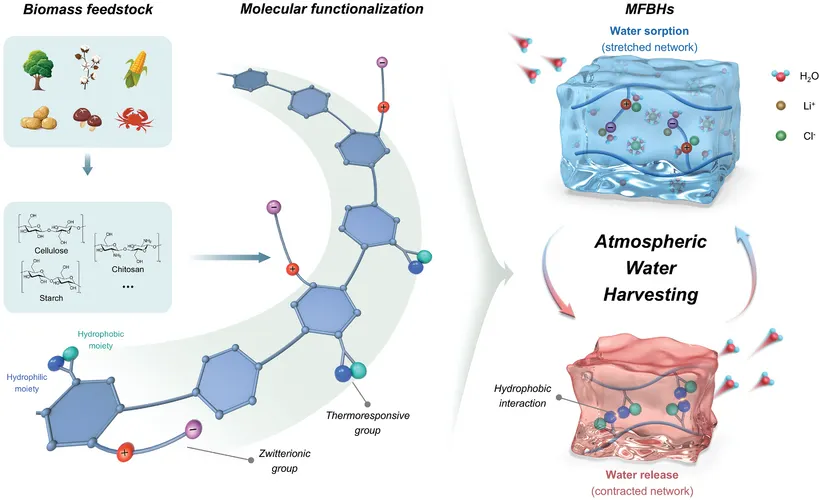Technology
Scientists Create Water-Harvesting Technology That Uses Kitchen Scraps and Seashells
Published
2 months agoon
By
admin
Researchers at the University of Texas at Austin have figured out how to turn everyday throwaways into a technology that pulls clean water straight from the atmosphere.
The team used different organic materials to develop “molecularly functionalized biomass hydrogels” that extract drinkable water from air using only mild heat, producing nearly four gallons daily per kilogram of material—about three times more than typical water-harvesting technologies.
“This opens up an entirely new way to think about sustainable water collection, marking a big step towards practical water harvesting systems for households and small community scale,” said Professor Guihua Yu, who led the research team.
The research is relevant today, considering nearly 4.4 billion people have restricted access to safe drinking water, according to recent studies. That’s nearly 50% of the entire human population.
Extracting water out of air is not really new, but what sets this approach apart is its use of natural materials that would otherwise end up in landfills—making it safer and more environmentally friendly too. The researchers successfully converted cellulose (found in plants), starch (from foods like corn and potatoes), and chitosan (from seashells) into high-performance water harvesters.
“At the end of the day, clean water access should be simple, sustainable, and scalable,” said Weixin Guan, another researcher involved in the study. “This material gives us a way to tap into nature’s most abundant resources and make water from air—anytime, anywhere.”
The technology works through a two-step process. First, researchers attach thermoresponsive groups to make the materials sensitive to temperature changes. Then, they add special molecules called “zwitterionic groups” to boost the biomass’ water absorption capacity.

The result is a hydrogel that works somewhat like the silica gel packets found in a normal dehumidifier, but with dramatically better performance and safer composition, using natural materials instead of synthetics.
During field tests, the system demonstrated to be successful—a single kilogram of material produced up to 14.19 liters of water daily. The team says similar technologies typically generate between 1 and 5 liters per kilogram each day.
Unlike conventional water harvesting systems that often rely on energy-hungry refrigeration to condense atmospheric moisture, these hydrogels need only mild heating to 60°C (140°F) to release their captured water—a temperature achievable with simple solar heating or waste heat from other processes.
This minimal energy requirement makes the technology particularly promising for off-grid communities and emergency situations where power might be unavailable.
Professor Yu’s team has been developing water-generating technologies for years, including systems adapted for extremely dry conditions and injectable water filtration systems. They’re now working on scaling production and designing practical devices for commercialization, including portable water harvesters, self-sustaining irrigation systems, and emergency drinking water devices.
Edited by Andrew Hayward
Generally Intelligent Newsletter
A weekly AI journey narrated by Gen, a generative AI model.
Source link
You may like


XRP Price Shoots For 20% Surge To $2.51 Amid Pullback To Breakout Zone


Stocks edge higher ahead of big earnings week


Here’s How Bitcoin Could Boost Demand for US Treasuries, According to Macro Guru Luke Gromen


Experts Predict US Recession in 2025 if Trump-China Trade War Tariffs Stay


Monero Jumps 51% After ‘Suspicious Transfer’ of $333M in Bitcoin


ZachXBT flags suspicious $330M Bitcoin transfer triggering Monero surge

Disclosure: The views and opinions expressed here belong solely to the author and do not represent the views and opinions of crypto.news’ editorial.
Crypto is out of narratives, out of patience, and running out of time to matter. The only way out is forward—by building products people actually use and don’t have to think about. For the past several months, AI agents have been pitched as that future, but most of them are just noise: flashy wrappers that don’t actually do anything.
In the middle of a macro meltdown, with Ethereum’s (ETH) value against Bitcoin (BTC) hitting five-year lows and Bitcoin trading like a high-beta tech stock, no one is begging for another DEX, bridge, or wallet extension. The problem isn’t discoverability. It is a utility. We’ve built an industry optimized for speculation, not service. A financial arcade, not a functioning economy. Most crypto apps don’t have users because they don’t solve anything real.
Volatility is the tell. If crypto were used at scale, real demand would anchor the price. But when macro conditions shift, the whole sector moves in lockstep—because actual usage doesn’t matter. That’s not a UX issue. That’s a product problem.
If crypto wants to survive this phase—let alone escape the echo chamber in the next cycle—we need to stop building abstractions for each other and start building real products for real people.
Why it keeps happening
Crypto has never grown out of its builder-for-builder roots. Success is defined by shipping, not retention. We reward composability over usability. Launches over DAUs. TVL over usefulness.
That’s how we ended up with a wave of AI agents that look good in demos but fall apart in practice—built to impress, not to endure. Builders build for other builders. Teams optimize for token launches, not long-term users. Most roadmaps are driven by narrative timing, not customer feedback. The result? Products that impress on crypto Twitter but don’t matter to anyone outside of it.
User experience is still considered surface-level polish when it should be foundational. We talk about onboarding like it’s a marketing problem, not an architectural one. And we wonder why users churn faster than altcoins collapse.
Not all AI agents are the answer
Take a look at what’s been happening with AI agents in crypto. We’re pretending automation means intelligence. But users don’t need agents that talk. They need agents that do.
And they need agents that can operate with intent: taking autonomous action, interacting onchain, and accruing value, not just information. If this is going to be the narrative of the next cycle—and it might be—we need to raise the bar. What’s missing isn’t another chatbot. It’s autonomy, action, and economic alignment.
The next generation of agents must be onchain actors—agents with memory, incentives, and agency. Not just slick AI interfaces, but participants in the network itself.
What a real product looks like
A real product solves a real problem—clearly, quickly, and without friction. It doesn’t need an explainer thread. It feels like magic, not a UI puzzle. In crypto, the magic moment happens when a product abstracts away the protocol, when it does something for the user without making them think about networks, wallets, or bridges.
Imagine an AI agent that quietly monitors your wallet, and the moment your airdrop unlocks, it claims it and sells at optimal execution—no prompts, no extra steps. At the same time, it watches gas prices and dips into stable-yield reserves you forgot you had, automatically buying the dip without you lifting a finger. When you need to bridge funds or execute a transaction, it instinctively reroutes you through the cheapest and fastest network available, all without asking which chain you’re on or forcing you to approve a dozen steps. That kind of seamless automation isn’t a feature. It’s the foundation of a real product.
These aren’t features. They’re outcomes. And they’re the foundation of actual adoption.
And so these are the kinds of applications crypto needs to hone in on and devote resources to. Real consumer AI agents are a breakthrough here. They act on behalf of users, claiming, trading, and coordinating. They reduce surface area. They make infrastructure invisible. They don’t rely on speculative hype to attain value; they provide an actual service.
That’s how we get crypto out of the power user corn maze and into everyday relevance.
What needs to change (and why now)
This isn’t just about good design. It’s about product discipline. And the timing has never been better. We’re not just in a bear market. We’re in a trust correction. Retail is gone. The ETF narrative is priced in. Altcoins are bleeding out. The Fed and fiscal policy are driving every headline.
This is the best possible time to build—because no one’s watching. There’s no pressure to chase yield or force hype. There’s room to build quiet conviction around something real. So what should builders actually do?
First, they need to design for behavior, not just composability. It’s not enough that components can plug into one another—what matters is whether people actually use them. Real product design starts with the user’s motivation and workflow, not with modularity.
Second, builders should use automation and agents to reduce decision fatigue. Most crypto products overwhelm users with options. The goal should be to eliminate choices, not add more. A great product handles complexity behind the scenes so the user doesn’t have to think.
Third, it’s time to prioritize retention over liquidity mining. If your product only works because there’s a token incentive attached to it, it’s not a product—it’s a promotion. Focus on building something people come back to without needing a bribe.
Finally, usability should be treated as infrastructure, not decoration. The interface is not the cherry on top—it’s the bridge between function and experience. If it’s not intuitive, it’s broken.
AI agents for consumers aren’t a gimmick. They’re the best shot we have at building something people actually return to. Not because they believe in your token. But because the product does something for them.
Stop building for nobody
We don’t need more tokenized interfaces. We don’t need more demos that explain themselves better than they perform. And we definitely don’t need another yield mechanic disguised as a product.
We need software that helps people get something done. That they come back to because it works, not because they’re speculating. Consumer AI agents are the clearest path to that future. Stop building apps no one uses. Start building ones that people don’t even have to think about.

Garrison Yang
Garrison Yang is the co-founder of Mirai Labs, a web3 development studio building intuitive consumer applications that make crypto usable—and useful—for everyone. With over 15 years of experience across engineering, strategy, growth, and product, Garrison blends technical depth with a marketer’s eye for impact. A former professional gamer, he brings a competitive edge and a deep understanding of user behavior to everything he builds. At Mirai, he’s focused on turning blockchain into something people actually use—without even realizing it.
Source link
cross-border payments
Boosting growth in the tokenized credit market
Published
1 week agoon
April 18, 2025By
admin
Disclosure: The views and opinions expressed here belong solely to the author and do not represent the views and opinions of crypto.news’ editorial.
Over the past decade, the tokenized credit market has soared to new heights. The industry, which converts traditional credit products, such as loans, bonds, or other debt instruments, into digital tokens that exist on a blockchain, has helped to democratize the world of investment for more participants, with each token issued representing a fraction of the underlying credit asset. This fractionalisation allows the token to be easily traded, transferred, and managed on decentralised platforms.
To date, $10 billion in tokenized bonds have been issued by leading institutions, including the World Bank and the City of Lugano. The market’s growing popularity stems from the significant benefits it offers—enhanced liquidity, transparency, and accessibility. Investors can now buy and sell portions of loans or bonds, making these traditionally illiquid assets more flexible and tradable. Blockchain’s transparent, immutable ledger ensures that all transactions are secure and verifiable in real time, reducing fraud and increasing trust. Additionally, tokenized credit products open the door to a broader pool of investors by lowering entry barriers, allowing even small-scale participants to invest in assets that were once limited to large institutional players. As more financial institutions and platforms adopt tokenization, this market is expected to expand, transforming how credit products are issued, traded, and managed.
Yet despite this advancement, the growth of the tokenised credit market is still constrained by one critical issue: return on investment. Decentralized finance lending currently offers lower yields when compared to traditional lending markets, especially in the current high-interest rate environment.
This can be solved by providing funding for cross-border payments as it is an ideal use case to expand the tokenized credit market and unlock higher yields, offering consistent cash flows and a natural fit for blockchain’s speed and cost-efficiency.
The core challenges: Low yields and volatility
The total allocation of the tokenized credit market remains relatively small compared to the size of the multi-trillion-dollar global bond market. The limited allocation is largely due to challenges in liquidity, investor hesitancy concerning yields, and regulatory uncertainty.
Concerning returns, the tokenised credit market currently offers an average yield of around 9.65% on $10 billion of tokenised credit assets. While this might seem attractive compared to traditional bond yields, tractional private credit markets saw average yields of 12% from 2018 to 2023, leading many investors to still view DeFi as volatile and uncertain. Therefore, to unlock further growth, it is critical that the industry addresses yield-related issues and enhances investor confidence in the pioneering asset class.
Institutional investors demand not just high yields but also stability and predictability. In traditional credit markets, low volatility and reliable income streams are key drivers of investment flows, whereas the DeFi sector is still seen as nascent and volatile. The ecosystem needs to prove that it can generate attractive, risk-adjusted returns for both institutional and retail investors. This means improving the robustness of the platforms and expanding the range of available asset classes, such as into payments.
Increasing yields to boost growth
To drive greater adoption and attract more capital into tokenised credit markets, several strategies are necessary to make yields more attractive:
- Enhance liquidity. One of the key factors limiting yield attractiveness is liquidity, as tokenized assets must have deeper secondary markets to allow investors to exit positions easily without significantly affecting prices. This can be achieved by expanding the number of platforms that offer trading of tokenized debt assets, and increasing institutional participation can help create the necessary liquidity for more stable returns.
- Broaden asset classes. The tokenized credit market is currently focused on a narrow range of assets, such as mortgages and corporate bonds. However, to make yields more appealing, the market needs to diversify into other asset classes. Tokenizing revenue-generating assets like payments, real estate, and infrastructure projects could provide higher yields and open up new opportunities for investors who are seeking different risk-return profiles.
- Leverage stable asset classes. Integrating more stable, low-risk asset classes into the DeFi ecosystem could help balance the risk-reward equation. For example, tokenized government bonds or investment-grade corporate debt could offer lower but more stable yields, which may be attractive to institutional investors or pension funds looking for secure, long-term returns.
Finding new asset classes for tokenization
To ensure sustained growth in the tokenized credit market, new asset classes must be explored. The current landscape focuses heavily on fixed-income instruments, but there are untapped opportunities in sectors including real estate, intellectual property rights, royalties, and even carbon credits.
However, the payments industry presents the best asset class for the expansion of the tokenized credit market. Playing a fundamental role in all global commerce, the payments industry handles extremely high transaction volumes with largely consistent returns. Cross-border payments are of particular interest; each provider must maintain sufficient liquidity in each jurisdiction in which it operates to provide fast and low-cost transactions, forming a significant burden for aspiring founders and scaling payment companies.
This burden creates huge inefficiencies and locks up capital that could otherwise be invested or otherwise used more productively elsewhere. The tokenized credit market offers an effective solution to this problem, lending to cross-border payment companies to enable them to operate pre-funded accounts in more jurisdictions, reaching a market untapped by traditional lenders due to high perceived risks and archaic due diligence processes. Utilising on-chain collateral for loans and offering highly flexible lines of credit, the tokenised credit market can go where the traditional private lending market never could, gaining access to a key source of transaction volume and higher yields.
The future of tokenized credit markets
As the tokenised credit market continues to evolve, funding payments companies stand out as an important asset class that can generate higher yields and attract more capital, enabling the tokenised credit market to take the next step in its growth.
To ensure the broader DeFi ecosystem thrives, the sector must focus on enhancing liquidity, stabilising yields, and diversifying into new asset classes, be that the payments industry or any other sector with high demand for flexible, on-chain liquidity.

Mouloukou Sanoh
Mouloukou Sanoh is an experienced investor and operator, with private equity and investment banking in his arsenal. He co-founded Cassava, Africa’s largest web3 platform, and led key investments at Adaverse, Cardano’s venture arm. He was on Forbes 30 Under 30 2023.
Source link
Technology
Now On Sale For $70,000: The World’s First Factory Ready Open-Source Humanoid Robot
Published
2 weeks agoon
April 16, 2025By
admin

Hugging Face is stepping into the world of humanoid robotics with Reachy 2, a $70,000 AI-powered robot designed and built by its latest acquisition, Pollen Robotics.
“So excited to start selling Reachy 2 this week, the first open-source humanoid robot!” Hugging Face co-founder Clément Delangue tweeted. “It’s expensive but already in use at Cornell, Carnegie Mellon & major AI labs for robotics research and education.”
While open-source robots are not new, Reachy 2 is the first manufactured, commercially available, open-source humanoid robot.
“Reachy 2 is a versatile, expressive, and open robotic platform designed to explore the future of human-robot interaction, assistive robotics, and AI-driven behaviors,” Hugging Face claims. The robot has a “humanoid upper body” and includes stereo vision, microphones, a speaker, and lidar.
Each of the robot’s arms has seven degrees of freedom, allowing it to move in seven independent directions, mimicking the flexibility of a human arm.
“Whether you want to build an expressive assistant, a teleoperated avatar, or a robot that learns from demonstration, Reachy 2 gives you the tools to make it happen,” the company said.
Reachy 2’s launch comes as Hugging Face, an AI company and platform best known for its open-source machine learning tools, expands into robotics. In November, the company said it was developing small language models for “Next Stage Robotics.”
Reachy 2 was developed by Pollen Robotics, a Bordeaux, France-based company founded in 2016. Pollen Robotics introduced the original Reachy in 2020.
It runs on Robot Operating System 2 (ROS 2) and Hugging Face’s LeRobotHF framework and is accessible via a Python-based software interface.
Beyond its technical specs, Delangue clarified who Reachy 2 is—and isn’t—intended for.
“It’s not a consumer robot,” he said. “It’s an AI lab robot so quite different.”
On Monday, Hugging Face announced that it had acquired Pollen Robotics for an undisclosed amount.
In a separate post on X, the company laid out its broader ambitions for Reachy 2 and the future of open-source robotics.
“We believe robotics could be the next interface for AI—and it should be open, affordable, and hackable,” the company said. “Our vision: a future where everyone from the community can build and control their own robot companions instead of relying on closed, expensive black boxes.”
While Reachy 2 is currently aimed at research institutions, Hugging Face’s investment in humanoid robotics suggests that the machines could play a larger role in the evolution of open-source AI.
Edited by Sebastian Sinclair
Generally Intelligent Newsletter
A weekly AI journey narrated by Gen, a generative AI model.
Source link

XRP Price Shoots For 20% Surge To $2.51 Amid Pullback To Breakout Zone

Stocks edge higher ahead of big earnings week

Here’s How Bitcoin Could Boost Demand for US Treasuries, According to Macro Guru Luke Gromen

Experts Predict US Recession in 2025 if Trump-China Trade War Tariffs Stay

Monero Jumps 51% After ‘Suspicious Transfer’ of $333M in Bitcoin

ZachXBT flags suspicious $330M Bitcoin transfer triggering Monero surge

Monero’s XMR Rockets 40% as XRP Leads Crypto Majors Gains

The 5 top crypto loan platforms of 2025

XRP Price Shows Strength — Breakout Above Key Levels Possible?

Expert Reveals Why The Ethereum-To-Bitcoin Ratio Is Falling

Analyst Says Solana-Based Memecoin Going Much Higher, Sees PENGU Facing ‘True Test’ After April Surge

Nike sued for $5 million over its shutdown of NFT platform RTFKT

Biological Age vs. Chronological Age: Redefining Age in the Digital Era

TRUMP whale regrets sale, pays double to buy back meme coins

Stripe Tests New Stablecoin Project as $3.7T Market Looms

Arthur Hayes, Murad’s Prediction For Meme Coins, AI & DeFi Coins For 2025

Expert Sees Bitcoin Dipping To $50K While Bullish Signs Persist

3 Voting Polls Show Why Ripple’s XRP Price Could Hit $10 Soon

Aptos Leverages Chainlink To Enhance Scalability and Data Access

Bitcoin Could Rally to $80,000 on the Eve of US Elections

Crypto’s Big Trump Gamble Is Risky

Institutional Investors Go All In on Crypto as 57% Plan to Boost Allocations as Bull Run Heats Up, Sygnum Survey Reveals

The Future of Bitcoin: Scaling, Institutional Adoption, and Strategic Reserves with Rich Rines

Sonic Now ‘Golden Standard’ of Layer-2s After Scaling Transactions to 16,000+ per Second, Says Andre Cronje

Ripple-SEC Case Ends, But These 3 Rivals Could Jump 500x

Has The Bitcoin Price Already Peaked?

A16z-backed Espresso announces mainnet launch of core product

Xmas Altcoin Rally Insights by BNM Agent I

Blockchain groups challenge new broker reporting rule

I’m Grateful for Trump’s Embrace of Bitcoin
Trending

 24/7 Cryptocurrency News6 months ago
24/7 Cryptocurrency News6 months agoArthur Hayes, Murad’s Prediction For Meme Coins, AI & DeFi Coins For 2025

 Bitcoin3 months ago
Bitcoin3 months agoExpert Sees Bitcoin Dipping To $50K While Bullish Signs Persist

 Ripple Price1 month ago
Ripple Price1 month ago3 Voting Polls Show Why Ripple’s XRP Price Could Hit $10 Soon

 24/7 Cryptocurrency News4 months ago
24/7 Cryptocurrency News4 months agoAptos Leverages Chainlink To Enhance Scalability and Data Access

 Bitcoin6 months ago
Bitcoin6 months agoBitcoin Could Rally to $80,000 on the Eve of US Elections

 Opinion6 months ago
Opinion6 months agoCrypto’s Big Trump Gamble Is Risky

 Bitcoin6 months ago
Bitcoin6 months agoInstitutional Investors Go All In on Crypto as 57% Plan to Boost Allocations as Bull Run Heats Up, Sygnum Survey Reveals

 Bitcoin3 months ago
Bitcoin3 months agoThe Future of Bitcoin: Scaling, Institutional Adoption, and Strategic Reserves with Rich Rines


